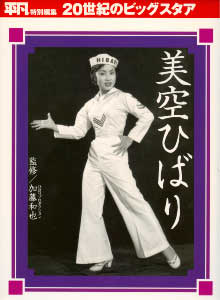

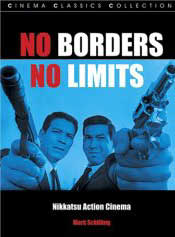
By Mark Schilling
2007
Paperback
154 pages
$16
This is just a heads up for fans of older Japanese films to be on the lookout for this book. It covers a period and genre of films that hasn’t received much attention outside of Japan and has very little written about it in English. From the late 1950’s to the early 70’s Nikkatsu produced boat loads of action films full of tough guys, beautiful dames, jazzy scores and hard edged dialogue. During the peak years over 100 films were coming out a year, but by the mid 60’s the entire Japanese film industry went into decline and the Nikkatsu action films began a slow fade as well. It had a short rejuvenation in the early 1970’s with a move to a more hip rock action genre with the Stray Cat series but by 1973 the company had switched over completely to their pink film content.
Schilling is a well-known expert on Japanese film with his current job reviewing films for the Japan Times, his programming involvement in the Udine Far East Film Festival and two previous books. He clearly shows affection for these films as well as an extensive knowledge of them and the actors and directors responsible for them. He first wrote this book as an accompaniment to a Nikkatsu Action Retrospective at Udine and has now expanded it for publication. The book is broken down into five sections – a history of Nikkatsu, the major actors, the major actresses, a few of the lesser billed actors and a few of the main directors. There are also a generous amount of color poster images strewn throughout the book. It is well written and easy to get through and to someone like me who knew absolutely nothing about this period very informative. As nice as this is, I would have appreciated it even more if Schilling had added three more sections for the uninformed – one with reviews of a number of his favorite films, another comparing Nikkatsu action films to the action films the other companies were producing – what made the Nikkatsu films unique - and thirdly a helpful listing of which of these films are currently available with English subtitles.
This third point of course points out the frustration of reading
a book like this – as far as I know very few of these films are available
with subtitles – a number of the Seijun Suzuki films certainly and a small
smattering of some of the others such as Black Tight Killers. One positive
though is that this may be changing. Currently some of the films that showed
at the Udine Retro are slowly making their way around the United States
thanks to the endeavors of Subway Cinema’s Marc Walkow and Nikkatsu is
hoping to find a distributor in the states to take a package of these films.
That would be delicious.

Contemporary Japanese Film
By Mark Schilling
Paperback
399 pages
$25
1999
This is one of the few books in English that covers recent Japanese films without a specific genre focus such as yakuza, cult or a particular director. Schilling has been reviewing films for The Japan Times for some 16 years while living over there and has gained an enormous amount of knowledge on the subject and has written a number of books on Japanese cinema and culture. This is a fairly simple endeavor – to a large degree much of it was already written by Schilling and he just needed to organize it into this useful book.
The film breaks down into a few major sections.
There are three essays on contemporary Japanese cinema totaling about 30
pages – followed by interviews with many prominent directors – Masahiro
Shinoda, Yoji Yamada, Shunji Iwai, Juzo Itami, Takeshi Kitano and Hirokazu
Koreeda to name six of the 15 directors – and this is followed by his reviews
written for the Japan Times from 1989-1999 – around 400 in all. The main
problem of course for most of us is that Schilling caught these in the
theaters and I assume speaks Japanese – most of these are unobtainable
on DVD with English subs. His reviews though are always informative and
well written and can at a minimum be used as a reference for films from
the 90’s and for future DVD releases over here.
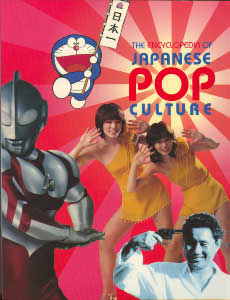
Encyclopedia of Japanese Pop Culture, The
By Mark Schilling
Paperback
325 pages
$23
1997
This isn’t specifically a book devoted to film,
but is instead a compendium of various pop cultural happenings over the
past 40-50 years. So it includes a variety of things from celebrities to
music to fads to films and sheds some light on many things I had seen referenced
before but had never quite understood. The book tackles some 67 cultural
pop phenomenons in alphabetical order – often devoting a number of pages
to each. Some of the topics covered are: Doraemon, Instant Ramen, Karaoke,
Pink Lady, Pachinko, Shonen Jump, Tora-san and Ultraman. This is also where
I first came upon Misora Hibari and I am for that quite grateful. Easily
readable, fun and informative.
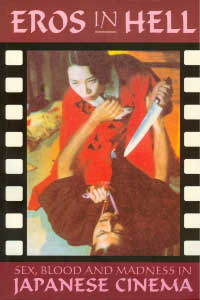
Eros in Hell
By Jack Hunter and Contributors
Paperback
210 pages
$20
1998
I have to say that I am not a “pinku” fan in particular and am not at all familiar with the genre or the films talked about in this book. Still many Westerners associate Japanese film with many of the extreme themes that “pinku” films immerse themselves in – bondage, rape, S&M and other various fetishes that you won’t come across in your local Blockbuster. The first chapter gives a high level view of the origin of the “pinku” film which begins in the early 1960’s, but really exploded later on in the late 60s’ and early 70’s when the film studio Nikkatsu converted over to almost exclusively producing films of this genre.
Other subjects covered in the ensuing chapters are:
2 .The films of Koji Wakamatsu who was one of the first and most eminent “pinku” directors who mixed sex and political themes – the film “Go, Go Second Time Virgin” may be the most familiar to Westerners.
3. The third chapter focuses on rape and torture films that fall under the term “ero-guro” films.
4. This chapter is devoted entirely to the classic film “In the Realm of the Senses” directed by Nagisa Oshima,
5. The works of director Hisayasu Sato who has been one of the premiere “pinku” directors of the 80’s and 90’s and whose films are a clash of sex, violence and psychosis.
6. Even perhaps more disturbing is the subject matter of this chapter – “Ultraviolence – Sex, Slaughter and Sacrifice” that details films (accompanied by some gruesome photos) of extremely graphic violence as in the “Guinea Pig” series.
7. The seventh chapter consists primarily of an interview with Takao Nakano who has specialized in outrageous trashy films full of nude females, tentacles, female wrestling and so forth.
8. The final chapter veers away from traditional “pinku” films into more recent independent experimental punk films such as those by Sogo Ishii and Shinya Tsukamoto.
Though the material covered in this book may
feel exploitive, the writing is not – it is very measured and informative
and is enlightening about a genre that is for the most part a mystery to
me and in all honestly will with perhaps a few exceptions remain that way.
Somewhat at odds to the serious writing style are the enormous number of
black and white film stills that are in fact quite exploitive for the most
part with reams of naked breasts and bondage being thrown at the reader.
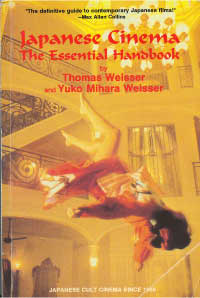
Japanese Cinema
By Thomas Weisser and Yuko Mihara Weisser
Paperback
331 Pages
$20
The film books from Weisser – this one and his book on Hong Kong films – have been smacked around for years and for some fairly good reasons. They basically consist of nothing but 2-3 paragraph reviews of hundreds of films and so one would expect that they would be fairly accurate as the books exist only for this reason. But as has been chronicled by people with much more knowledge than I have, the reviews are often very wrong – just the basic facts and often to such a large degree that one has to assume that Weisser either never watched the films and took his information from elsewhere such as the back of the video box or he watched them years before he wrote the reviews and simply didn’t remember them all that well.
Nevertheless, even with that preface for many
Asian film fans there was practically nowhere else to turn for information
on films pre-internet days and before a flood of other books came out and
his terse pulp descriptions of the films often sent us scurrying off to
find them by hook or by crook. The same can be said about the Japanese
films he covers – there are films he writes about that can be found nowhere
else internet included. The only problem is of course that most of the
films are not available and so you can only dream of someday coming across
them. His bent is for extreme, action and exploitation films and the book
has a number of small black and white photos accompanying the reviews.

Japanese Film: Art and Industry, The
By Joseph Anderson and Donald Ritchie
Paperback
477 pages
$25
1982
“Are movies made in Japan” was a comment made in the United States in the 1950’s to an emissary from the Japanese film industry and this book makes clear that in fact Japan has an enormously rich and diverse film history that goes back to the beginning of the 20th century. For anyone that wants to receive a thorough background in Japanese film history up until the late 1950’s, I can’t imagine a better book than this. This covers trends, themes, directors, studios, film technique and much more in a manner that is scholarly but still fairly digestible. The only issue is that the book throws out so many titles, actors and directors at you in its dense format that it is impossible to retain much more than impressions at a high level the first time through. What it leaves you with though is an incredible desire to learn more about it and to see many of the films referenced – some of them sound fascinating.
The book is relayed in chronological order
beginning with silent film era and the use of the “benshi” – who narrated
the films to the audience – and the slow transition to talkies that led
to the demise of the “benshi” tradition. Following chapters cover the pre-WWII
period describing the creation of the major studios and the advent of a
group of young directors who were to change the face of Japanese films
for decades to come. Two chapters are devoted to the film industry during
the war and then he details how the industry adapted to the post-war conditions
under the censorious eye of the U.S. occupation. Another 100 pages take
up the films of the 50’s. The films referenced tends to focus very much
on the classic directors – Ozu, Mizoguchi, Mikio Naruse, Kurosawa
- as one might expect but there are also loads of films discussed by much
lesser known directors. Sections are also included with biographies of
the prominent directors as well as some of the better known actors - even
including one on Hibari Misora! In truth I was not really ready for this
book due to the paucity of classic films I have seen but I am glad I did
so anyways because it gives me a much higher appreciation of Japanese film
even if the details are still quite fuzzy in my mind.
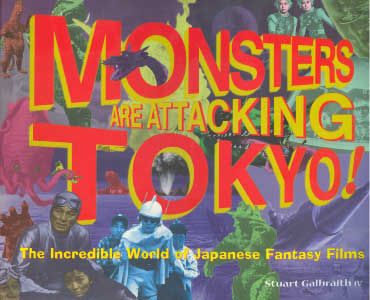
Monsters are Attacking Tokyo
By Stuart Galbraith
Paperback
191 pages
$17
1998
Many of us had our first contact with Japanese cinema as youngsters sitting around the television watching giant monsters thrash each other or demolish cities though at that age few of us had a clue that the films were coming from some foreign land far far away. As we grew older many of us stopped watching these films as something from our childhood and moved onto to other things, but Galbraith makes a strong case that this uniquely Japanese genre (Kaiju eiga) should be held in higher esteem and not looked down upon as campy laughable escapism. Much of this image by Westerners was derived from the fact that the films we saw were often poorly re-edited and dubbed. At the time of their most prolific period – the 1950’s and 1960’s – these films were in fact as advanced technically as any sci-fi coming out of Hollywood and were very popular in Japan. They were not considered B-films in Japan in the same sense that much of the sci-fi was that came out in Hollywood was during this time and they helped turn around the Japanese film industry after WWII.
I have not been a big fan of these films and
have admittedly seen very few since childhood, but was recently extremely
impressed by the first Godzilla shorn of the dubbing and Raymond Burr.
It took on a completely different persona - it was no longer campy but
was actually a very melancholic film about the state of humanity at the
time. So it is interesting to read a book that takes these films seriously
though this is in no way an academic treatise – but instead a heartfelt
fan valentine to them. The film is broken down into four main sections
– an overview of the genre from the beginning to the date of the book,
an index of the major players in the genre, an assortment of interviews
with many of these and finally short reviews of about 100 films. The only
thing I would have preferred was his organizing the interviews differently
– he breaks them up to address certain aspects of the genre while I think
I would have preferred simply reading the interviews of individuals in
total. There are also lots of images to go along with this. This is an
easy enjoyable introduction to the world of Kaiju Eiga!
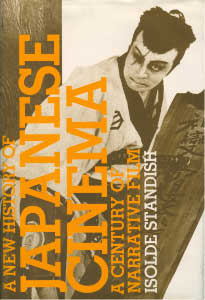
New History of Japanese Cinema, A
By Isolde Standish
Hardback
341 pages
$40
2005
The picture (Tange Sazen) on the cover of the book misled me into thinking that this might be a populist foray into the history of Japanese film, but it was far from that. This is a very academic, scholarly and well researched work that details how historical, social and cultural changes in Japan affected the content and themes of films or as Standish writes “an approach that attempts to reach an understanding of the relationship between filmmaking practice, the contexts of the economic and sociopolitical, and their connections to narrative themes in cinema”. She follows this with “In order to avoid a reductionist analysis and in view of the often nonlinear and nondiachronic nature of “history” as it imparts on human experience”. This last sentence gives a perhaps extreme indication that getting through 341 pages might be an arduous task and in truth I gave up for a while, but I later returned to the book with a different mindset and found much of what it relates to be very interesting and that it delves into areas that I had not come across in my other readings on Japanese film.
The book isn’t so much interested in the films
themselves in terms of critical analysis, but instead uses various films
to explore cinematic themes and relating these back to what was taking
place in society. She delves seriously into the pre-WWII growth of nationalism
and how films reflected this, the strict guidelines of WWII censorship
and the explosion after the war of a very humanistic wave of films from
Kurosawa and others that was offset later by the introduction of the Japanese
“New Wave” of Oshima and other young hard edged directors. Though her chronology
of films is quite up to date – “Ichi the Killer” is referenced – the amount
of material written on films after 1990 is fairly limited. For those interested
in a serious slog through Japanese film history, this contains a lot of
useful information and thinking.
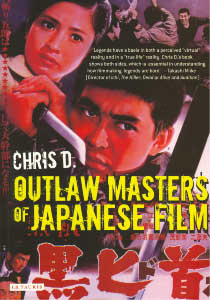
Outlaw Masters of Japanese Film
By Chris Desjardins
Paperback
255 pages
$15
2005
As a programmer for the influential American Cinematheque, Chris D. was one of the early voices in the West to espouse and expose Japanese films that fell outside of the typical serious classical works from Ozu and Kurosawa. These films that are primarily from the 1960’s and 1970’s were pure pulp explosions of joy from the genres of the yakuza, samurai and exploitation and were a revelation to many – they just reeked with cool. He displays an astonishing knowledge of these films – most still unavailable in the West – in this book that is a fan friendly love letter to the films he clearly cherishes.
The format of the book is fairly simple – he devotes a separate chapter to those directors that he considers “outlaw” masters – i.e. they broke with convention and by doing so made some of the great films of our time. He also includes two actors who are cult icons. Each chapter is broken into three sections – an overview of their work, a filmography and an interview with them. In the overview many of their films are discussed and the interviews generally are of 5-6 pages in length. The directors covered are:
Kinji Fukasaku
Eiichi Kudo
Junya Sato
Kihachi Okamoto
Kazuo Ikehiro
Masahiro Shinoda
Yasuhara Hasebe
Seijun Suzuki
Teruo Ishii
Koji Wakamatsu
Takashi Miike
Kiyoshi Kurosawa
And the two actors are Sonny Chiba and the fabulous Meiko Kaji.
Both the individual overviews and interviews
are informative and easy to take in and one is constantly impressed by
how deep his knowledge on these films. At times the interviewee is quite
surprised as well that someone from the West knows so much about their
movies. In the appendix he also includes a short essay on female action
films and a short look at the various film studios.
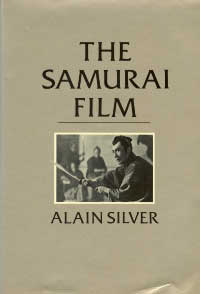
Samurai Film, The
By Alain Silver
Hardcover
236 pages
$24
1983
The samurai film is perhaps Japan’s most unique genre of mainstream film - while giant monsters or Yakuza films have their antecedents in similar western genres the samurai film is closest to the soul of the country. Samurai films go back to silent era and though there have been periods in which it has diminished in popularity they are still being made today and the popularity of the recent films from Yoji Yamada (“Twilight Samurai”, “Hidden Blade”) reconfirm this long lasting affinity with the Japanese audience. Other than simply often being terrific action films and dramas, the Samurai film also imbues itself with themes of honor, sacrifice, obligations, rebellion against the power structure, loyalty to friends, family, clan and country – all themes that resonate well in Japanese society. Characteristics that they perhaps yearn for in the same way that Westerns appealed for such a long time to the urban masses of America. Pre-WW II the samurai films generally were referred to as “jidai-geki” in which the period drama tended to overshadow the action, but beginning in the 1950’s the genre took on a different face – one of questioning authority and loads of action – referred to as “chambara”. It is these latter films that Silver focuses on for this book. This is considered the golden age of the Samurai film – the mid 50’s to the mid 70’s – and numerous classic films were produced.
This book is considered the authority on the Samurai film – it is not a pop exploration of the genre but approached very much from a serious film perspective (Silver has written on various other film genres) with in depth analysis on the genre, directors and specific films. It is highly informative though at least for me at times too analytical – especially of films that I have not yet seen – though I would definitely want to revisit this work after seeing some of these films to see what he had to say. He covers the basics though he spends very little time on the more extreme or cult like samurai films – a short mention of Lone Cub, none of Lady Snowblood for example. Here is what the book does cover.
1. A few chapters to put the films in historical
and cultural context.
2. Akira Kurosawa
3. Dissects three films in chapter 4 – “The
Ambitious”, “Hari-Kiri” and “Rebellion”
4. A terrific chapter that delves into the
series of Zatoichi, Crimson Bat and Son of the Black Mask as well as the
character of Miyamoto Musashi in his various film incarnations.
5. A lengthy welcome chapter (55 pages) on
the films of Hideo Gosha.
6. The final chapter touches on directors
Kihachi Okamoto, Masahiro Shinoda and the decline of the samurai film towards
the end of the 70’s.
7. There is also a glossary of terms and filmographies
of directors with cast information.

Stray Dogs and Lone Wolves – The Samurai Film
Handbook
By Patrick Galloway
Paperback
234 pages
$20
2005
The author approaches his subject very much from the perspective of a fervent fan of the genre as opposed to an academic analysis. He makes this clear in his introduction when he states first that he just feels the genre hasn’t been covered sufficiently in English and that writing the book saved his marriage! Of course, it may do damage to your relationship because reading his book will likely lead you to wanting to watch more samurai books than your significant other will want to put up with. For those already well versed in the subject there may not be a lot new here, but Galloway’s writing is fairly entertaining and his film reviews are enthusiastically rendered.
The first four chapters are basic background
material – he puts the samurai film into historical context, gives a high
level overview of the genre and the film companies that were behind them
and has some biographical information on the major directors and stars.
He follows this with 51 two to three page reviews that are in chronological
order beginning with Rashomon in 1950. The reviews are well-written
and easy reading and have a certain dramatic tension to them as he relates
the major plot points. He also often includes some additional information
on the production, some of the character actors and so on. One really strong
point for me is his actor identification of all the characters. The films
covered are the major ones – but he gives equal time to the serious classics
and to the pulp classics. His selection criteria appears to be films that
are readily available and so unfortunately (and really the only weakness
of this book) he doesn’t cover any films that are somewhat obscure. So
for any one with an interest in knowing more about the samurai film, this
is a terrific place to start.
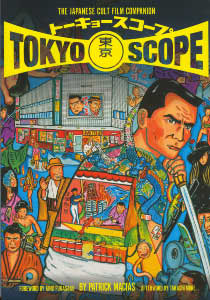
TokyoScope – The Japanese Cult Film Companion
By Patrick Macias
Paperback
235 pages
$20
2001
Over the past couple of years there has been a sudden surge of interest in Japanese films with the publication of books on samurai, Miike, horror and the yakuza along with the release of a number of older films on DVD in the West. But Macias was perhaps the first to tackle a wide range of films in English that fell outside of the usual study of Japanese film – i.e. Kurosawa, Ozu and such. He terms them “cult” films and I would perhaps disagree with that because many of these films were not considered cult films in Japan and were indeed mainstream fare but it is perhaps an easy manner to categorize the films he discusses.
The book is broken down by various genres/directors
in which he first gives a short introduction and then follows this with
a number of reviews (usually 8-10) of films pertaining to that genre. He
also mentions if the films are available, but since this was put out before
the recent explosion of Asian films distributed by the West on DVD it is
somewhat out of date. These genres are: Giant Monsters (Kaiju Eiga), Sonny
Chiba (a genre of a sorts), Horror, Yakuza, Kinji Fukasaku, Banned (5 Forbidden
Films), Pink and Violence, Panic and Disaster and he finishes with a chapter
on Miike. Within these he often has sidebar interviews with important contributors
to the genre or informational essays on subjects such as bios on Hiroyuki
Sanada, Etsuko Shihomi, Bunta Sugawara and Tetsuro Tanba among others.
The book is very much fan-based – clearly an ode to the films he loves
or thinks are cool. This is by no means an in depth examination of any
of these genres – it instead serves as a nicely packaged book to whet your
appetite and send you off looking for more.

Yakuza Movie Handbook, The
By Mark Schilling
Paperback
335 pages
$20
2003
As in all of his writing on Japanese film, Schilling produces a very informative and enjoyable read here as he delves into the world of the Yakuza film. His vast breadth of knowledge on Japanese film, history and culture is impressive and he brings this to the book. Being a respected reviewer for the Japan Times also allows him access to many of the important personalities within the industry and this results here in some great interviews. The book covers most of what anyone would want to know about the Yakuza films – at least from the perspective of someone like myself who is new to all of this.
Here is what the book contains:
1. A 21 page overview of the history of the
Yakuza film.
2. A number of profiles and sometimes interviews
with many of the prominent directors such as Kinji Fukasaku, Teruo Ishii,
Tai Kato, Kitano, Miike and Suzuki.
3. The same format is continued with actors
who starred in these films – Noboru Ando, Junko Fuji, Akira Kobayashi,
Jo Shisido, Bunta Sugawara, Ken Takakura, Koji Tsuruta and others.
4. The final section contains about 120 film
reviews that are broken into a summary of the film followed by a critique
of it – generally 4-5 paragraphs in total. Of course most of these films
are not available with English subtitles and so reading these reviews and
not having an opportunity to watch them can be more frustrating than rewarding
– but with the recent western releases of many older Japanese films hopefully
some of these will see the light of day.
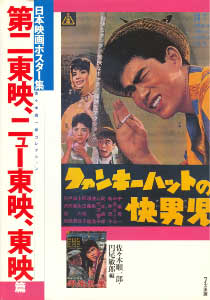
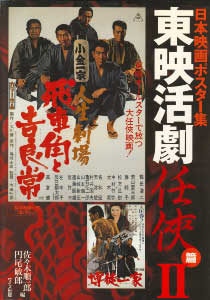
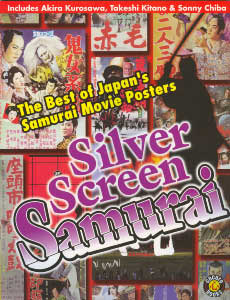

One of my favorite recent discoveries in Japanese film is the actress/singer Hibari Misora. She sings in all of her films and can charm you within an inch of your life. I picked up a 5 disc cd of her music which is wonderful and bought this hardcover book from cdjapan I believe. It is filled with hundreds of pictures of her from childhood to her death and many obviously from her films. It is 250 pages and cost about $50.
